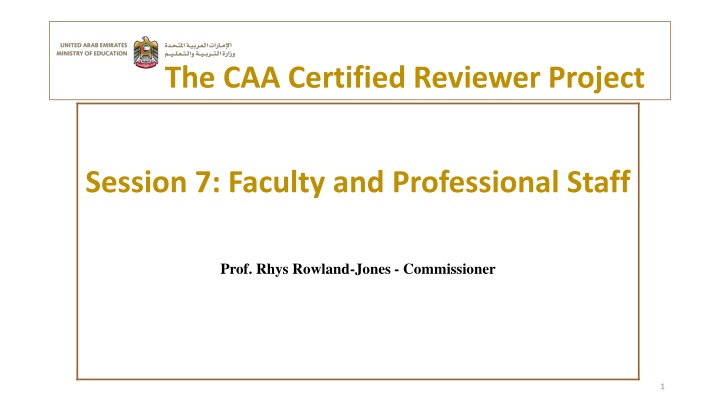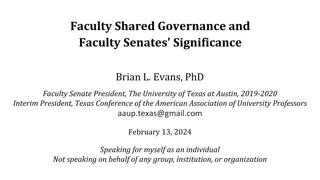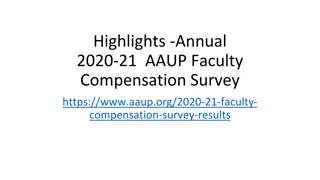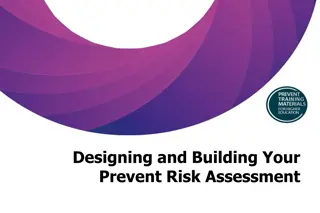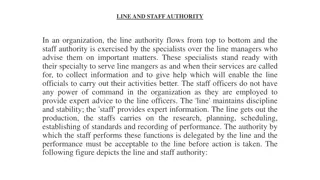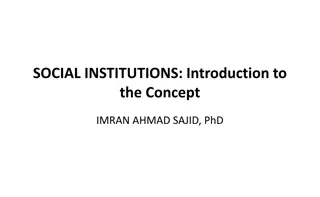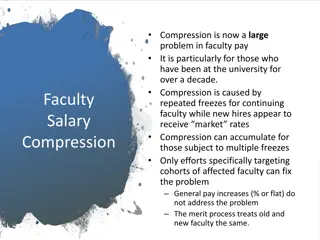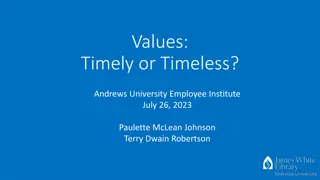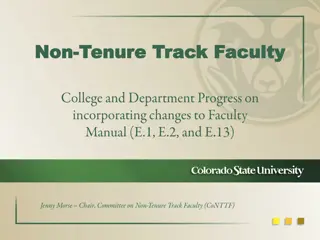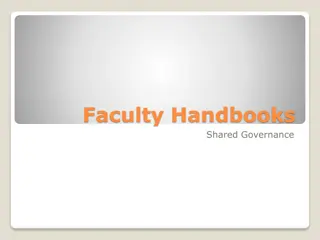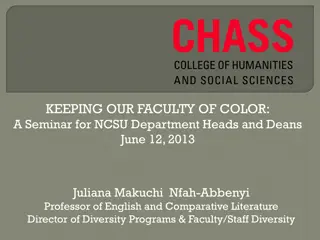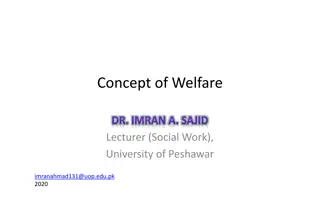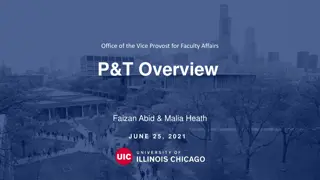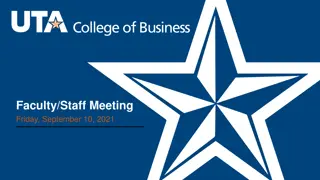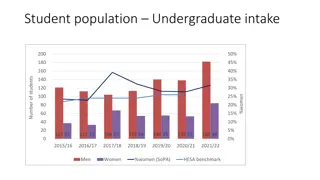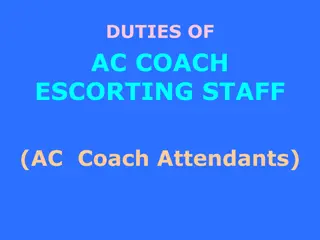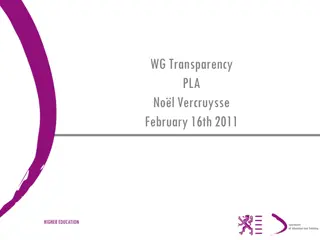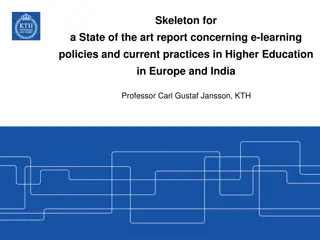Faculty and Professional Staff Guidelines in Higher Education Institutions
This content delves into the requirements and standards related to faculty and professional staff in Higher Education Institutions. It covers the qualifications, recruitment, development, workload, and ethical considerations of faculty members and professional staff members. The focus is on ensuring that the institution has qualified personnel to achieve its mission and support student learning effectively.
Download Presentation

Please find below an Image/Link to download the presentation.
The content on the website is provided AS IS for your information and personal use only. It may not be sold, licensed, or shared on other websites without obtaining consent from the author.If you encounter any issues during the download, it is possible that the publisher has removed the file from their server.
You are allowed to download the files provided on this website for personal or commercial use, subject to the condition that they are used lawfully. All files are the property of their respective owners.
The content on the website is provided AS IS for your information and personal use only. It may not be sold, licensed, or shared on other websites without obtaining consent from the author.
E N D
Presentation Transcript
The CAA Certified Reviewer Project Session 7: Faculty and Professional Staff Prof. Rhys Rowland-Jones - Commissioner 1
Presentation 20 minutes Existing ERT reflection 20 minutes Outline Q&A 15 minutes
The term faculty or faculty member refers to those employees of a HEI whose responsibilities are mainly in teaching and/or research. In some institutions the terms academic staff or teaching staff are used. Administrators, such as Deans, often concurrently hold appointments as faculty members Faculty and Professional Staff The term Faculty appears 298 times in the Standards
i The institution demonstrates that it has appropriately qualified faculty, administrative staff, and technical staff, of a sufficient number to meet all requirements of its programs, services, and activities, and to achieve its mission. All faculty members and professional staff hold appropriate credentials; their preparation and qualifications are suited to the level of their instructional assignments or areas of activity. Standard 5: Faculty and Professional Staff ii The institution supports professional standards for teaching and support of learning, including appropriate professional development and fair workload policies. iii The institution has orderly, transparent policies and processes for recruiting, developing, evaluating, promoting, and retaining faculty and professional staff, who exemplify diverse educational and cultural backgrounds.
5.1 Faculty Manual 5.2 Professional Staff Manual 5.3 Recruitment and Terms of Employment 5.4 Faculty Qualifications 5.5 Graduate Faculty 5.6 Professional Staff Qualifications 5.7 Faculty Workload 5.8 Part-time Faculty 5.9 The Roles of Faculty 5.10 Professional Development 5.11 Employee Records 5.12 Evaluation 5.13 Code of Conduct 5.14 Disciplinary Actions and Appeals 5.15 Grievances 5.16 Graduate Assistants Stipulation 5: Faculty and Professional Staff .
5.4 Faculty Qualifications A few deeper examples from Stipulation 5: Faculty and Professional Staff 5.5 Graduate Faculty 5.7 Faculty Workload 5.8 Part-time Faculty
5.4.1 the preparation and qualifications/credentials of all faculty members, both full-time and part-time, are appropriate to the field and the level of their assignments, and meet the minimum qualifications required for each level a sufficient number of faculty to ensure that the core program areas and all specialization courses are taught by faculty with qualifications in the field . qualifications of all faculty are documented through official transcripts, certificates, and certificates of equivalency from the UAE MoE faculty files are maintained and include passport and visa information, credentials, and up-to-date curriculum vitae Minimum degree levels obtained and subject areas (5.4.6 5.4.13) 5.4.14 faculty teaching online courses have an appropriate level of experience and training in the use of online instructional technology, as stated in an institutional policy approved by the Commission; 5.4.15 faculty members are competent in the language of instruction in the programs to which they are assigned; 5.4.16 there is diversity of cultural and educational backgrounds, and of gender, within its faculty, staff and administration. 5.4 Faculty Qualifications What are the ERT seeking assurance of?
faculty members who instruct in graduate programs hold a relevant specialist terminal degree evidence a strong record of active engagement in research and scholarship, including recent publications, or have significant professional experience in applied fields as practitioners principal supervisors of student research theses are from the full-time faculty employed at the institution who are research-active in their field, and have prior supervisory experience at graduate level clearly articulates and disseminates the eligibility requirements for faculty members teaching graduate courses as distinct from undergraduate courses faculty teaching and supervising theses/dissertations in doctoral programs have an extensive record of research and have experience in supervising graduate theses/dissertations 5.5 Graduate Faculty What are the ERT seeking assurance of?
a sufficient number of faculty members to effectively deliver the programs it offers a clear and accessible faculty workload policy. workload assignments are equitable and reasonable and include the entire range of a faculty member's responsibilities Workload assignments provide for a minimum release time as follows: a. at least three credit hours per semester for program coordinators and department chairs that are cumulative; b. at least six credit hours per semester for deans; c. appropriate release time for other major administrative and research assignments.: The calculation of workloads includes any classes that are split into sections, and takes into account the workload implications of classes taught in the evenings and/or on weekends policy to establish a faculty workload allocation for thesis/dissertation/graduation project supervision that is included in calculation of workloads and states limits for student supervision and advising as part of the normal teaching load. a policy on workload allowances for employees travel between campuses 5.7 Faculty Workload What are the ERT seeking assurance of?
5.7.4 The institution adheres to the following maxima with regard to faculty workload assignments a. 30 credit hours or equivalent per academic year, including the summer period (typically no more than 15 credit hours per semester) for non-terminal degree holders teaching in the General Education component of programs or in undergraduate Diploma and Associate Degree programs where the institution does not offer higher level degrees; b. 24 credit hours or equivalent per academic year, including the summer period (typically no more than 12 credit hours per semester) for faculty members with terminal degrees teaching in undergraduate programs. If exemption is granted by the CAA to allow faculty without a terminal degree to teach major courses, the limit of 24 credit hours will be applied to this faculty; c. 18 credit hours or equivalent per academic year, including the summer period year (typically no more than 9 credit hours per semester) for faculty only teaching in graduate programs, or pro- rata for faculty teaching a mix of undergraduate and graduate courses; d. 6 credit hours, or equivalent, per semester for part-time faculty. e. Teaching during summer term is calculated within the above limits (a-d) and cannot be mandated for faculty. 5.7 Faculty Workload What are the ERT seeking assurance of?
5.7.4 The institution adheres to the following maxima with regard to faculty workload assignments 5.8 Part-time Faculty normally no more than 25% of the instructors, by headcount, teaching courses in a given program are part-time faculty part-time faculty meet the same qualification requirements for appointment as full-time faculty; part-time faculty are employed on the basis of well-documented job descriptions and clear, equitable contracts policies and procedures, including provisions related to office hours, that apply to full-time faculty apply equally to part-time faculty 6 credit hours, or equivalent, per semester for part-time faculty. part-time faculty of partner institutions teaching in joint degree programs have experience and qualifications as required by the Standards What are the ERT seeking assurance of?
Summary Faculty provide a key element of any review Needs to demonstrate academic qualification and subject area Issues relate to workload and supervision Impact on program delivery, management and the student experience Staff qualifications essential library, IE, etc Part-time faculty numbers and workload Faculty development and support
